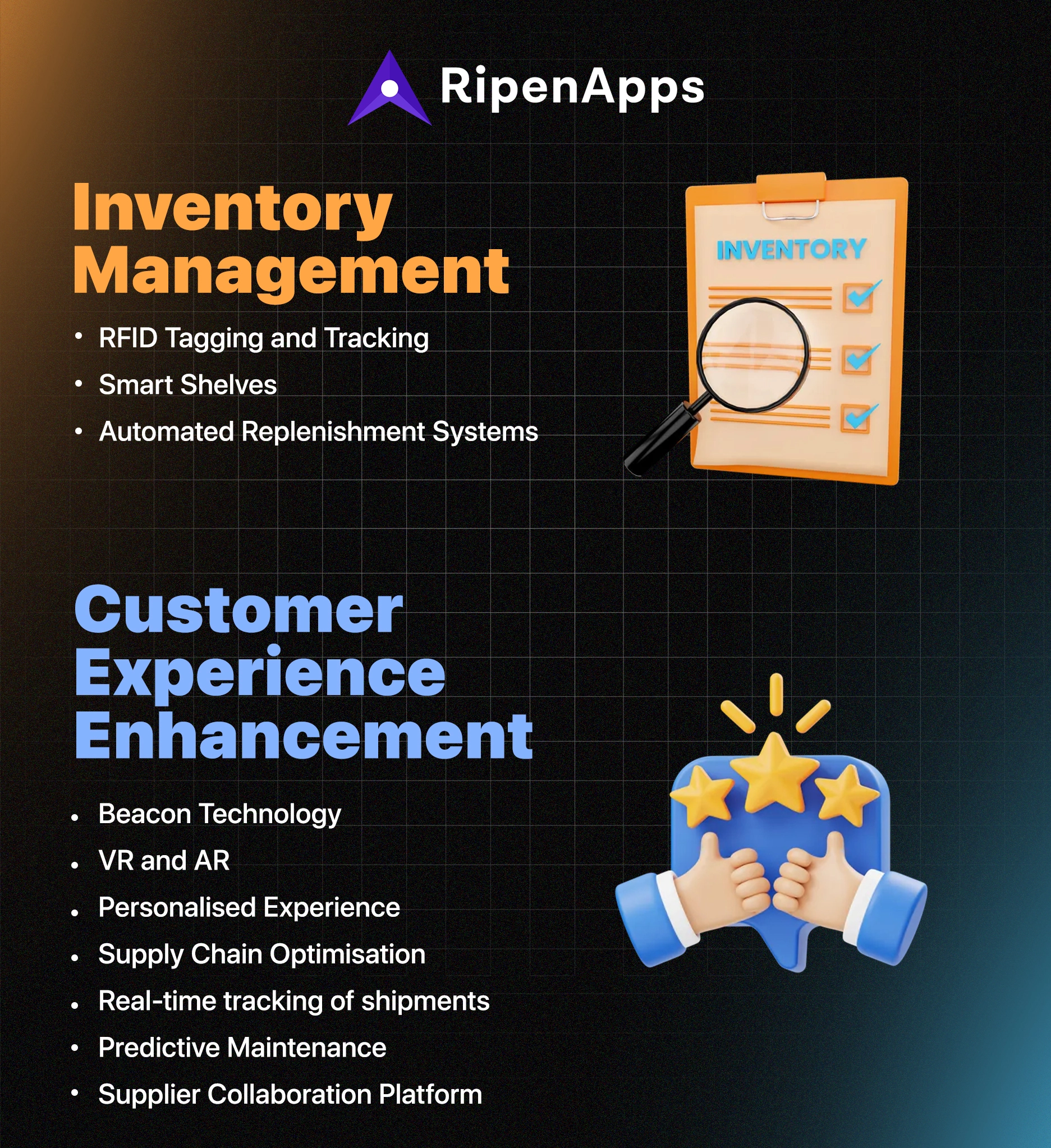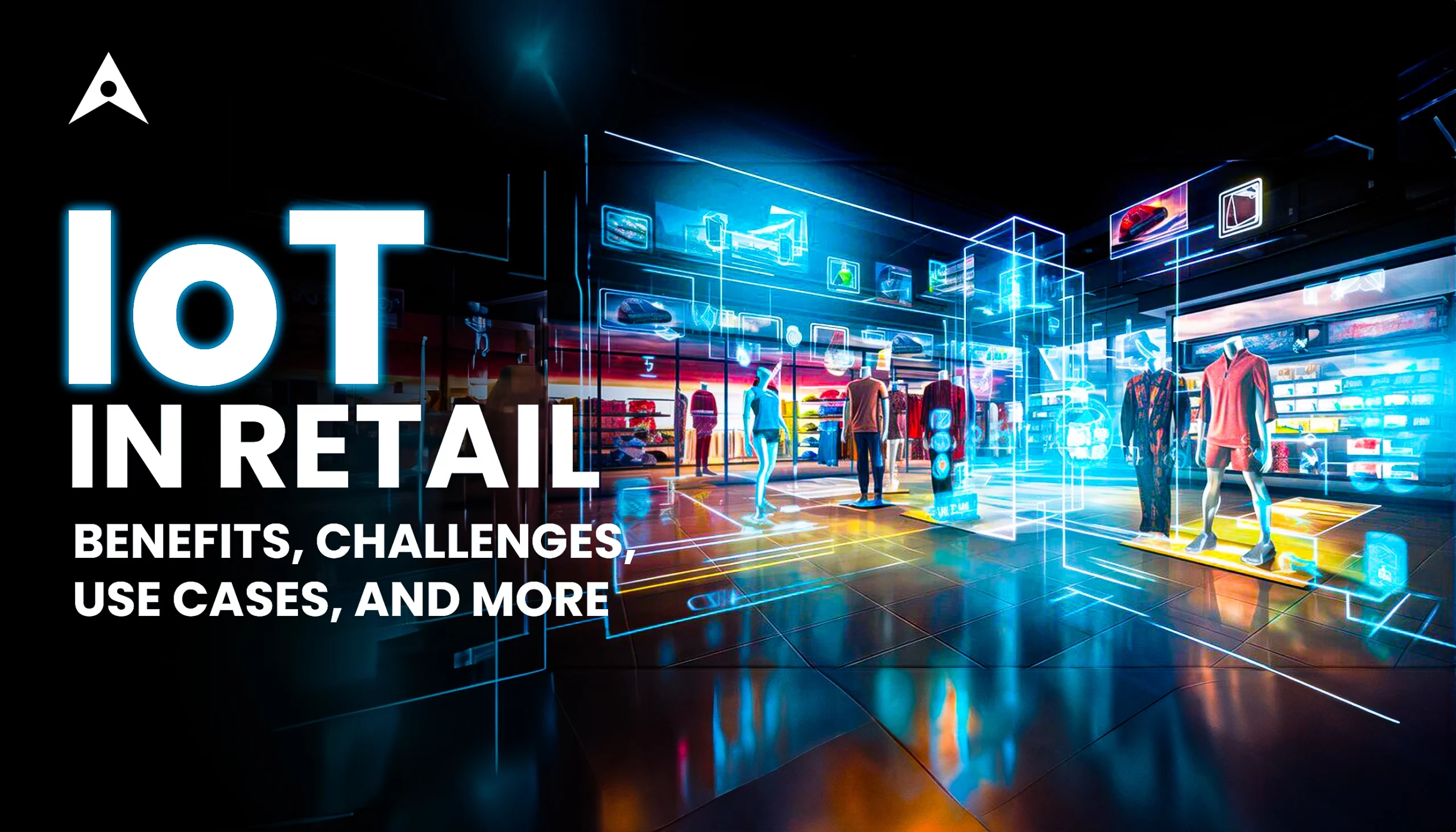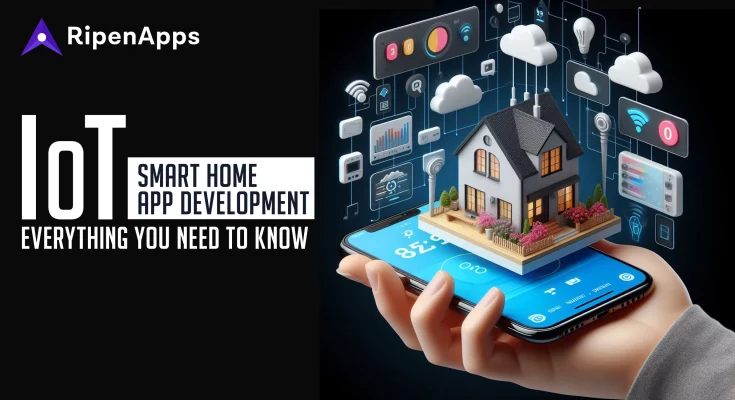Retailing was different compared to what it looks like today. When digitalization was yet to start, businesses used traditional methods of working. But, with the growing digitalization, businesses that ignored digitalization faced a downfall. Although the retail industry generates more than 25 trillion dollars, there is a heavy demand for smart retailing.
When it comes to smart retailing, the Internet of Things is strongly unlocking the doors to higher revenue and growth. A lot of businesses are incorporating the Internet of Things into their business to make it smart, efficient, and future-ready. A lot of real examples of retail businesses prove the same, including the top giants like Amazon and Walmart.
So, how can IoT solutions benefit your retail business? Well, this is what we will inform you about in this in-depth article about the use of IoT in retail: benefits, challenges, use cases, and future trends.
Table of Contents
What Benefits IoT In Retail Brings For Your Business?
Without a doubt, the Internet of Things highly contributes to satisfying customer demand in various ways. It allows us to connect the physical and digital worlds. Let us see the benefits of IoT in retail.
Customer Tracking
Who does not want to follow up with their audience? Until you do not track your audience, it is tough to study their buying behavior and preferences. Through IoT sensors, retail owners can track their customers’ movements, which further helps them analyze what they are interested in.
Automated Checkout
Product rows in your retail shop might have less rush as compared to your check-out counters. What if there is a technology that can scan the products for check-out automatically, reducing the frustration for customers who wait in line? IoT-based electronic tags can help you achieve the same. It will also reduce the cost of hiring billing people for your business.
Shopping Assistance
Sometimes a customer leaves your shop when he or she is unable to find the desired item on the shelf. This damages the complete shopping experience of customers at your store. However, IoT solves this problem by introducing shopping assistants. This allows customers to track the products from shelf to shelf, making the search for items quick and less effortful.
IoT Shelf Availability
In huge shopping malls, there are times when the shelf gets out of stock without instant notice to the authorities to refill the stock. Here, smart sensors can help notify businesses as a shelf goes empty. It can also deliver a stock report, letting owners know how long it took for the item to go out of stock. This reduces unnecessary spending on the items and buys products according to their out-of-stock time frames.
Real-time Promotions
Nearly 41% of marketers believe that real-time personalization benefits deliver better growth to a business. iBeacon technology allows mobile apps to connect and display notifications instantly on the user’s smartphone. With this IoT technology, you can promote discounts and deals in real-time if a customer passes by your shop or is even shopping inside.
Applications of IoT in Retail Industry
With the benefits mentioned above, it is also essential to understand the use cases of the Internet of Things in detail. Here are some of the top use cases of IoT in the retail industry.

Inventory Management
Supply chain optimization is one of the main tasks in the retail industry. According to Gartner, the supply chains that are at the top use the Internet of Things in their operations. Further, when you do it with technology, you avoid the risk of human errors in the inventory tracking process. Here are the few devices that are highly used in the inventory management process:
- RFID Tagging and Tracking: Loading an RFID tag with data and attaching it to an asset to achieve an asset-tracking system.
- Smart Shelves: electronically connecting the shelves to keep track of the inventory. As soon as the shelf goes empty, retailing authorities are notified.
- Automated Replenishment Systems: The system automatically generates orders when the inventory levels go down.
Customer Experience Enhancement
To enhance the customer experience, a business has to have an end-to-end understanding of customer interactions at each point in the retail store. In other words, you are keeping track of the customer journey to understand their preferences and their overall buying behavior. This in turn offers you better opportunities to create an excellent customer experience, unlocking growth for your business.
IoT can help you with customer experience enhancement in multiple ways:
- Beacon Technology: sending welcoming messages or deals to customers as they approach your retail store directly to their smartphones.
- VR and AR: Allowing shoppers to preview products like furniture or home decor using smartphones or in-store AR devices.
- Personalized Experience: Using multiple sensors, your store can collect the required data to personalize the overall experience for buyers.
- Supply Chain Optimisation: Supply chains are complicated, and there are multiple silos that retail owners want to address. These silos include efficient tracking of shipments or collaboration platform analysis. However, IoT can be beneficial in solving some of the silos.
Also read: IoT and Logistics – A Magical Amalgamation for Supply Chain Management
- Real-time tracking of shipments: IoT sensors can provide real-time data like location, temperature, and more, ensuring better control over assets.
- Predictive Maintenance: Gather data through IoT devices to access equipment, and machines, or predict their failures in advance so that your retail business stays smooth.
- Supplier Collaboration Platform: Collecting, storing, sharing, and tracking the complete information of suppliers in order to establish relationships effectively.
Challenges in Adopting IoT in Retail
The Internet of Things brings numerous benefits to a retail business and has the potential to revolutionize it. However, there are some main challenges associated with it. Here are these:
Data Storage Concerns
When a number of IoT devices work to make a retail store smart, there is a huge amount of data flowing through them. It is also essential to store complete data sets to study the patterns leading to an improved customer experience. But where do you store this huge amount of data? This is one of the key challenges that arise.
Security and Privacy Concerns
As we discussed in the above pointer about the huge amount of data being generated from IoT devices, securing them remains another challenge. The data is about the shipment, the customer’s movements, inventory, and whatnot. And, if the data sets are hacked by some other retail stores, they can know your resources through which you might be designing your key strategies. It is essential to know tips to build secure IoT apps for your business.
Integration with Legacy Systems
Legacy systems are old technologies set up in an infrastructure that has been handling operations. Whereas IoT systems are new sensors, software, and physical device-based computing. Connecting legacy and IoT remains a concern for most of the people involved in the retail industry. From security concerns to performance concerns, there is a lot involved in the integration of legacy systems with the IoT.
Scalability Concerns
Connect this concern with the points we discussed above. Since there are issues with integrating legacy systems with IoT, this in turn leads to scalability concerns. Further, scalability is affected when there are security, privacy, and storage concerns. This, in turn, has negative effects on the budget or resources of the organization in the long run.
High Investments
This is for sure: the Internet of Things is a booming technology. As a simple idea, the higher the demand, the higher the price. This is why IoT technology demands higher investments for businesses. Also, the more compact a sensor, the more it costs, because shrinking technology has always been costly. Hence, cost becomes a key concern for the retail industry while implementing IoT.
Skills Gap and Workforce Training
As IoT is a new technology, it requires skilled people. You must have complete knowledge to analyze the data collected from the IoT devices. Not only this but every time your IoT device faces issues, you have to hire skilled people to rectify them. Or if your store is huge, you have to train your workforce about IoT and smart retailing.
Best Practices for Successful Implementation of IoT in Retail
So how do you master IoT implementation and build a smart retail store? Well, there are some best practices for a successful implementation of IoT in the retail sector. Let us explore them.
Be Clear With Your Goals And Objectives
While you go for IoT prototyping for your store to convert it to a smart store, it is important that you have clear goals and objectives. Here are the important things to consider:
- Scope of the IoT prototype
- Conceptualization of Infrastructure
- Hardware selection with their integration
- Data analytics resources
- Security and privacy planning
- Scaling blueprints
Invest In Robust Infrastructure And Connectivity
Do not be afraid of investing. Of course, if you are planning to heavily digitize your retail store, you likely have the investment budget. Go for the below:
- High-speed networks
- Robust security measures
- Efficient data management and analysis
- Smooth-performing devices
Prioritise Data Security And Privacy
Take an example: What if your key datasets are with someone else who is your competitor? They have your customer’s data, shelf management, inventory tracking, and more; they have everything. So, do not ignore data security and privacy. Prioritize it heavily! Ensure the below pointers:
- Data encryption
- High level of authentication and identification
- Regular updates
- Defined access controls
Collaborate With Industry Partners And Experts
If you are not good with technology and are still planning to make your retail shop smart, you can collaborate with industry partners. Hire top-notch IoT app developers and collaborate with them to digitize your retail business effectively. You can also attend tech events to keep yourself updated about the Internet of Things.
Continuous Monitoring And Evaluation
A lot of businesses that invest in IoT systems sometimes ignore this pointer. It might look less important to you, but monitoring and evaluation are the main parts. When a cycle ends, you have to analyze the data and prepare for the upcoming cycle. Keep monitoring and evaluating your IoT equipment and the data sent by them.
IoT Case Studies and Examples in Retail Industry
It is time to discover real-life case studies and examples to support the information we have provided to you. There are so many brands that have transformed their retail businesses by implementing digitization. Have a look at them:
Walmart and IoT
Walmart is the biggest retail company. The company has 7 million unique IoT data points across the USA. In order to keep the food products in excellent condition, Walmart uses IoT technology to monitor every individual refrigerator. From controlling the temperature to preventing any kind of breakdown, the company is a great example of IoT in retail.
Amazon and IoT
Amazon has IoT-based cashierless technology being implemented in full-sized grocery stores. The high-tech stores allow customers to walk in, and purchase the products they want, and while walking out, they are asked to scan a QR payment for checkout. This directly takes payment from their added credit card in the Amazon app.
Zara and IoT
Zara, a clothing retail store, has applied RFID implementation to their stores. A tag is attached to all the items, allowing you to track their movement in real-time. With this, the company is able to track the inventory information of the items efficiently.
Sephora and IoT
Sephora, a leading retail store for beauty products, has implemented virtual reality-based IoT technology for its customers. With their virtual artist feature, users can get virtual makeovers. The app uses a camera, analyses your facial features, applies customization, and simulates a real makeover on your face that you can share with your friends.
Of course, companies must be using IoT for a lot of things, but we have just presented examples to demonstrate real-life usage.
Future Trends and Emerging Technologies in Retail Industry
Trends allow businesses to come up with new ideas and opportunities. And retail is a huge industry, with so much trending happening all the time. Here are some IoT trends to update you a bit, which might help you plan additional steps with IoT.
Adoption of AI and Machine Learning
That is for sure: early adopters of AI and machine learning will unlock ample benefits. These advantages are:
- Personalized recommendations will enhance the shopping experience and lead to higher conversions.
- Accelerated growth due to opening up for the opportunity as an early adopter
- Improved customer experience with virtual customer services
- Data-driven decision-making helps you predict market trends further.
Also read: How IoT is Used in Modern AI Applications?
Integration of Blockchain for Supply Chain Transparency
Blockchain is another way of having complete visibility from start to finish. It is like tracking assets, where nobody can alter the ledger. This, in turn, helps retail businesses unlock:
- Efficient inventory management
- Enable transparency
- Enhance the customer experience
Growth of IoT-enabled Smart Cities
With cities having free Wi-Fi connections at public connections and outside stores, we are moving steps ahead to smart cities. And, with technologies like Beacon, we are enabling IoT. So, it will become essential for businesses to adopt smart store operations.
Concluding Thoughts- IoT in Retail
IoT in retail is the next big thing, for sure. From inventory management to real-time promotions, there are ample benefits that IoT offers retail stores. Also, with an experienced IoT app development team, you can overcome the challenges associated with it. In the near future, we will see smart cities highly enabled with IoT technology. Now is the right time to invest in IoT technology and make the first move in the highly competitive retail world.









 India
India USA
USA Australia
Australia Canada
Canada UK
UK UAE
UAE